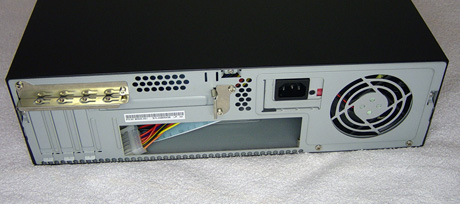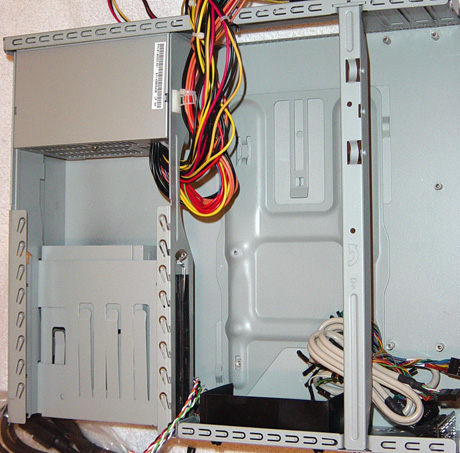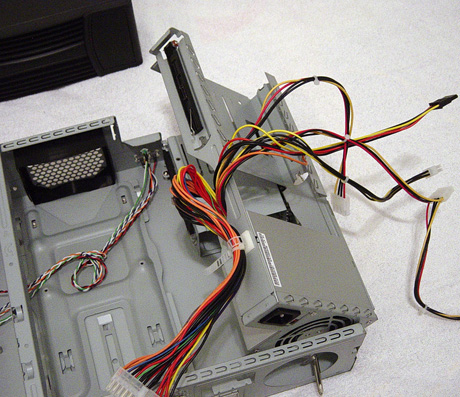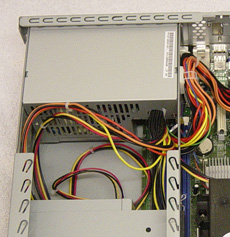Intel's Long Awaited BTX Form Factor
by Purav Sanghani on November 15, 2004 5:31 AM EST- Posted in
- Cases/Cooling/PSUs
First Look: AOpen B300 BTX case
External DesignAt first glance AOpen's B300 chassis included with Intel's evaluation kit seems like a normal half height ATX desktop case. The only thing that sets the B300 apart from ATX form factor cases of this size is the placement of the drive bays on the left side instead of the right. Still, at first glance it will seem like it's only a minor design change. We also notice there is a large section of the bezel which looks to be designed as a ventilation of some sort for an 80mm or even a 90mm fan mounted on the inside as an intake.

Click to Enlarge
At the far right of the bezel is a small door which opens to the right to expose four USB ports, audio ports, and a FireWire port.

Click to Enlarge
To remove the cover we need to remove three screws at the back of the case. We then slide the cover foreward about an inch and lift to remove it.

Click to Enlarge
Internal Design
Inside we see the drive bays at the front of the case on the left side. There is a single 5-1/4" drive bay which makes use of "optical fixing bars" to secure optical drives in place. Beneath the 5-1/4" bay is space for two 3-1/2" HDDs also utilizing the same fixing bars to secure them in place. Though AOpen implements these screw-less devices here, many screws are still used elsewhere throughout the case. Ironic, isn't it?

Click to Enlarge
To get to the 3-1/2" drive bays AOpen has designed the case in a way that this entire right section, which includes the drive bays and power supply, can be unfolded from the rest of the case out to the right. This feature helps reduce clutter when installed the motherboard as well as drives into their bays. To unfold this section there are 3 screws that need to be removed, 1 at the front and 2 at the back below the power supply. We then pull the frame forward and turn it out to the left.

Click to Enlarge
Directly behind the drive bays and mounted to the fold out frame is the FSP 275W SFF power supply with an 80mm fan. The clearance between the drive bays and the power supply is only a few inches which worried us a great deal. HDDs come in SATA interfaces but most all optical drives have an IDE interface right now. Combined with the power supply's cabling, things will definitely become claustrophobic.
 Click to Enlarge |
 Click to Enlarge |
The entire section to the right of the fold out tray will be taken up by the BTX motherboard. We noticed a metal plate on the motherboard tray called the Support Retention Module which can be removed.

Click to Enlarge
According to Intel this plate will provide extra support for the motherboard and retention for the thermal module due to the weight of the heatsink. The motherboard tray itself is made up of this entire section. Again AOpen has simplified things by using stand-offs for the outer edges of the motherboard while supporting the middle sections of the D915GMH with the retention module.










77 Comments
View All Comments
HardwareD00d - Monday, November 15, 2004 - link
Instead of spending all the money to research BTX, Intel should have just made watercooling standard on the Prescott CPU. Apple could have said they stole the idea from them like everything else ;)Omega215D - Monday, November 15, 2004 - link
It looks like Intel needs all the cooling it can get. I found an interesting article at Toms Hardware and here;s the closer about its heat problem "So, should a vendor release a product that is only able to run at its maximum performance under special circumstances? The fastest processors certainly are very exclusive devices, but that should not cause more troubles than necessary. The customer wants products that simply work! Think about that before releasing faster products, Intel." All I can say is wow, because I can remember my P3 866 didn't need all that cooling though now I moved on to AMD.HardwareD00d - Monday, November 15, 2004 - link
It sounds like you can essentially get the same thermal performance from an ATX case by adding 1 additional case fan.At least Intel has decided not to push this new form factor down peoples throats. Honestly, that's what I figured they'd try to do.
Gatak - Monday, November 15, 2004 - link
To have the powersupply and drive bays at the bottom is a good thing. It will keep the temperature more balanced inside the case and also provide more room at the top for cards and for exhaust fans, rather than craming everything up there.Pythias - Monday, November 15, 2004 - link
ROFL #6!!Ecmaster76 - Monday, November 15, 2004 - link
If a retail board showed up to a review with that horrible a component layout, it would be figuratively flogged.I find that the review was somewhat flawed since it failed to see what would happen with a discrete graphics card in the box. If one was used, I didn't spot it in the screenshot of the full ATX or uBTX screeshots, and it wasn't mentioned in the text.
Finally it should be mentioned that many people have theorized that the BTX layout would not work well for the Athlon64's onboard memory controller because of issues with trace layout. I'm no expert, but it does look like it might get a little tight.
ksherman - Monday, November 15, 2004 - link
"Anand's *vacation* work trip to Taipei..."Probably one of the funniest things i have read in one of your reviews.... ;)
raskren - Monday, November 15, 2004 - link
As always, so much Intel backlash, simply because, its Intel.This is how cases should have been done originally. Align all the hot components and put a fan in front and behind them. Makes sense, right?
Current ATX design is "put a fan on every hot item you have". At least that's how my case is.
LoneWolf15 - Monday, November 15, 2004 - link
To me, BTX looks like a winner for only one niche: small form factor business desktops. By that definition, I don't include Shuttle's wonderful SFF PC's which work best for home and HTPC enthusiasts. The microBTX form factor looks great for an office environment where quiet operation is a real plus, as well as power consumption, and since business PC's don't need to be cutting-edge, middle-end processors can be used that don't generate a lot of heat.Tor the enthusiast however, BTX looks like a bust to me, more of an attempt by Intel to throw the market out of whack, specifically AMD's market. Enthusiasts already have case designs meant to exhaust a lot of air and keep systems cool. Many enthusiasts LIKE a little bit larger case so that they have more expansion room, with the exception of their HTPC, and so that they can house a decent power supply for that expansion.
I see HP, Compaq, IBM, and other mainstream business computing giants adopting BTX; it will probably do well in the business market as well as in mass retail, where OEMs would rather make a system with less fans to fail and at cheaper cost. That's a pretty big sector for profit of course, but this form factor, IMO, leaves PC enthusiasts out in the cold.
Beenthere - Monday, November 15, 2004 - link
BTX is obviously NOT a great design. Intel changes sockets, Mobo and other specs periodically to FORCE people to update to their latest crap. Don't expect a rush to BTX. It's another Intel spec unlikely to ever gain foothold...For those who don't already know you can do wonders for ATX case cooling with "managed airflow". By actually directing incoming cool air to the heat sources and isolating the CPU fan from warm air in the case, no one really needs a BTX case and your PC will run much cooler with managed airflow.
While Intel definitely needs a tornado inside a box to cool their defective 90 nano CPUs, the BTX standard is just another Intel marketing scam for all practical purposes.
Just say NO !